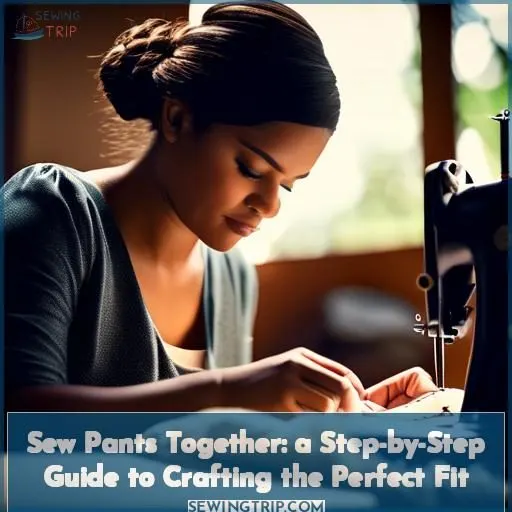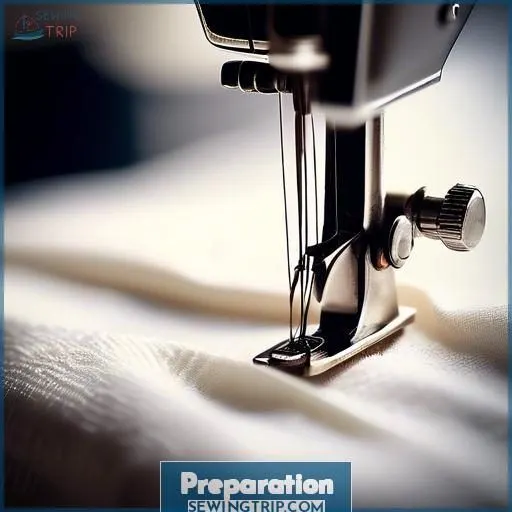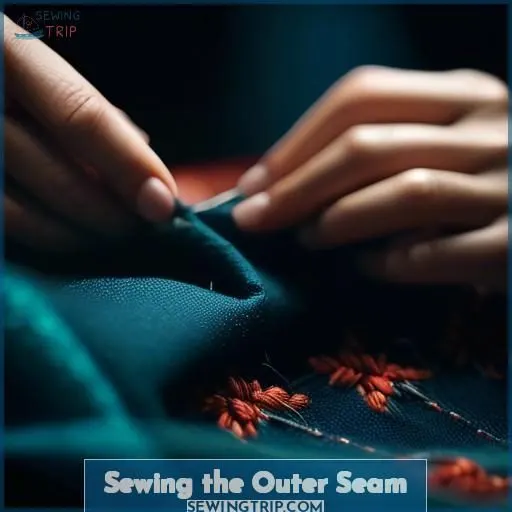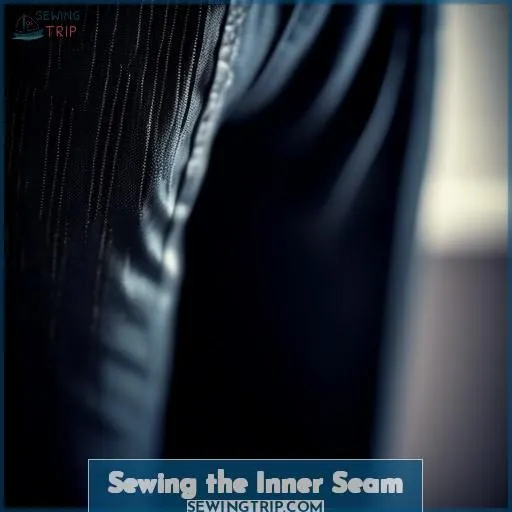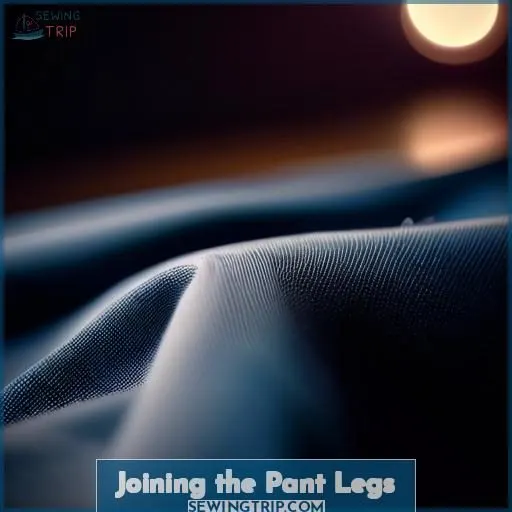This site is supported by our readers. We may earn a commission, at no cost to you, if you purchase through links.
To sew pants together, you’ll first need to choose the correct pattern size based on your measurements and cut out the fabric along the pattern edge. Next, construct the outer seams by aligning the fabric edges with your seam allowance guide and maintaining a steady sewing pace.
For the inner seams, select the appropriate pattern size, cut out the material, and sew each pant leg evenly. Then, join the pant legs by matching the inseams and pinning the crotch seam before stitching it together.
Finish by creating an elastic waistband that provides a comfortable, well-fitting pair of pants. Following these steps will help you sew pants that meet your unique style and body shape.
Table Of Contents
Key Takeaways
- Choose the correct pattern size and fabric for your sewing project, considering factors such as fiber content, care instructions, and the project’s purpose.
- Cut out the fabric along the pattern edge with precision, ensuring the pattern is printed on grain and the edges are aligned with the seam allowance guide.
- Sew the outer and inner seams, maintaining a steady sewing pace and pressing the seams flat for a professional finish.
- Create an elastic waistband that provides a comfortable, well-fitting pair of pants by measuring your waist, selecting an appropriate elastic length and width, and inserting the elastic through the casing.
How Do You Sew Pants Together?
To sew pants together, you should follow a specific order of operations. The order in which seams are sewn affects the hang of the garment. The last seam sewn where two or more seams cross will become the dominant seam.
For example, if you want dress trousers to hang properly, the crotch seam needs to be sewn after the inseams are sewn. If you want jeans to hang properly, the inseam needs to be sewn after the crotch seams are sewn together.
Additionally, you should consider the type of pants you’re making and the details involved. For example, if you’re adding cargo pockets, it’s easier to do so before the outseam is sewn.
Preparation
Before you start sewing, make sure you’ve chosen the right pattern size and fabric for your needs. Once you’ve got everything laid out, carefully cut the fabric along the pattern edge to prepare it for assembly.
Choose the Correct Pattern Size and Fabric
To choose the correct pattern size and fabric for your sewing project, follow these guidelines:
- Pattern Selection: Begin by selecting a pattern design that suits your needs. Consider the type of garment you want to create and the style you prefer. For example, if you’re making pants, choose a basic elastic-waist pattern with no zippers or pockets.
- Fabric Choice: Select a fabric that’s suitable for your chosen pattern. Consider factors such as fiber content, care instructions, and the project’s purpose. For pants, choose a medium-weight fabric like cotton twill or linen blends for everyday wear.
- Sizing Guide: Take your body measurements, including hip and neck/shoulder circumferences, and compare them to the size chart on the pattern envelope. Choose the pattern size that best fits your measurements.
- Fabric Cutting: Make sure the fabric is properly prepared for cutting. Make it piece perfect by removing surface finishes and aligning the lengthwise and crosswise threads or wales and courses.
- Pattern Matching: Check that the pattern is printed on grain, with the printed design lined up with the lengthwise and crosswise yarns or wales and courses.
Cut Out the Fabric Along the Pattern Edge
Trimming the fabric along the pattern’s border is a critical step in constructing pants. Confirm that the pattern’s positioning and fabric selection are appropriate prior to cutting. Precision is essential for an ideal fit, so utilize a ruler and a washable pencil for marking.
Safety pins can assist in holding the pattern in place on the fabric. Adhere to the pattern’s directions for aligning the edges.
If sewing a crotch seam, employ a basting stitch initially for accuracy. Recall to align the center front and back seams, and pin the back and front seams.
Sewing the Outer Seam
After cutting your fabric with precision, it’s time to tackle the outer seam of your pants. Set your sewing machine to the right stitch length, ensuring your thread matches the fabric. Place the fabric under the presser foot, aligning the edges with the seam allowance guide.
As you sew, keep a steady pace; this isn’t a race. Remember, serging or topstitching can add durability and a professional touch. Once done, press the seams flat.
This step is your foundation, so take pride in your craftsmanship.
Sewing the Inner Seam
To sew the inner seams of each pant leg, you’ll want to make certain of a perfect fit. Start by selecting the appropriate pattern size and material**. Once you’ve chosen your materials, place the pattern pieces on the material and pin them together. Then, cut out the material along the pattern edge.
After sewing the outer seam, it’s time to deal with the inner seams. Sew the inner seams of each pant leg, making sure they’re even and smooth. This step is essential for creating a pair of pants that are comfortable and fit well. Remember to press and pin the seams before sewing to make sure they’re accurate.
Joining the Pant Legs
Now that you’ve sewn the inner seams of your pant legs, it’s time to join them together. Here’s how:
- Matching inseams: Lay one pant leg on top of the other, matching the inseams.
- Pinning crotch seam: Pin the crotch seam at 1-inch intervals to guarantee a smooth fit.
- Creating U-shaped crotch: Pin the front edges together, making sure the center front edges match. This will create a U-shaped crotch.
Remember to smooth out the fabric as you pin, ensuring a comfortable fit. Once you’ve pinned the crotch seam, you’ll be ready to stitch it together.
Elastic Waistband
Now, let’s address the elastic waistband, the underappreciated feature that makes sure your pants fit you just right. First, measure your waist to determine the elastic length required, guaranteeing comfort without constriction. Opt for an elastic width that harmonizes with the casing width, allowing effortless passage.
For the casing, fold the fabric top down twice, creating a comfortable home for your elastic. Bear in mind that the elastic material should be pleasant to the touch, avoiding any unpleasant itching.
Insert the elastic through the casing, stitch the ends together, and presto, you’ve conquered the craft of the perfect fit!
Frequently Asked Questions (FAQs)
How do I choose the correct fabric for sewing pants?
When selecting fabric for pants, choose breathable, durable materials such as cotton, linen, or polyester blends. Consider the intended purpose – lightweight fabrics for summer, heavier ones for cooler weather. The suitable fabric guarantees a comfortable, long-lasting fit.
What are the best methods for taking accurate measurements for pants?
To create a perfectly fitting ensemble, take your measurements like a seasoned professional. Wrap that reliable measuring tape snugly around your waist, hips, and inseam – no embellishments, just the raw data, my dear. Your ideal trousers are merely a measurement away.
How do I sew a muslin to fine-tune the fit of my pants?
Sewing a muslin for pants is like tailoring a suit – it takes patience and precision. Start by pinning the muslin, then baste and try it on. Tweak until it fits like a glove.
What is the best order to sew the seams of pants for optimal hang and comfort?
First, sew the outer leg seams. Then, stitch the inseams. Next, join the crotch, ensuring a smooth, comfortable fit. Finally, secure the waistband elastic for a polished, flattering finish. This logical flow creates pants that flatter your figure.
How do I properly finish the waistband of elastic-waist pants?
First, fold the waistline down twice and press. Sew a line 1/8 from the bottom, leaving a 2 gap. Thread elastic through, stitch ends together, and you’re all set! Adjusting the fit is a cinch.
Conclusion
Imagine creating a pair of pants that perfectly hug your waist and flatter your figure. By following the steps outlined in this guide, you’ll be well on your way to sewing pants that look and feel custom-made for you.
From selecting the right pattern size to constructing a comfortable elastic waistband, this step-by-step process will empower you to sew pants that seamlessly complement your personal style.
Get ready to enhance your wardrobe with pants that were made just for you.

